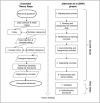"Place-finding" as the key to reintegration after release from prison in older age: A transdisciplinary, holistic and strengths-based reintegration framework using grounded theory
- PMID: 40526775
- PMCID: PMC12173364
- DOI: 10.1371/journal.pone.0325497
"Place-finding" as the key to reintegration after release from prison in older age: A transdisciplinary, holistic and strengths-based reintegration framework using grounded theory
Abstract
Prisons globally face an 'ageing epidemic,' releasing unprecedented numbers of older adults into the community. Research highlights substantial challenges in reintegrating this underserved and marginalised group. Urgent work is needed to understand their needs and develop effective social, criminological, and public health solutions. This study aimed to create a transdisciplinary, strengths-based conceptual framework to understand and begin addressing the reintegration needs of older individuals leaving prison. Applying grounded theory to qualitative data from Australia - including interviews and workshops with stakeholders and individuals with lived experience - resulted in the development of the 'Place-finding' conceptual framework. Successful reintegration can be understood in terms of a journey through stages of "institutionalisation," "crisis," "survival & adjustment," and "grounding". The framework posits that incarceration produces a 'loss of place' in individuals, primarily through institutionalisation and disconnection from society. It argues for the consideration of the right supports at the right time for the unique needs of individuals who will vary in their levels of disconnection. It finds key concepts such as facilitating timely access to services, reconnection with society, building key literacies and healing and restoration from past experiences to be vital in this journey. This preliminary framework offers novel theoretical insights and practical implications for understanding and improving reintegration success in older adults, and is potentially applicable to individuals of various ages, incarceration length and location.
Copyright: © 2025 Ye In Jane Hwang. This is an open access article distributed under the terms of the Creative Commons Attribution License, which permits unrestricted use, distribution, and reproduction in any medium, provided the original author and source are credited.
Conflict of interest statement
The authors have declared that no competing interests exist.
Figures






Similar articles
-
Towards a patient-centred definition for atopic dermatitis flare: a qualitative study of adults with atopic dermatitis.Br J Dermatol. 2024 Jun 20;191(1):82-91. doi: 10.1093/bjd/ljae037. Br J Dermatol. 2024. PMID: 38287887
-
Assessing the comparative effects of interventions in COPD: a tutorial on network meta-analysis for clinicians.Respir Res. 2024 Dec 21;25(1):438. doi: 10.1186/s12931-024-03056-x. Respir Res. 2024. PMID: 39709425 Free PMC article. Review.
-
Smoking cessation support preferences among people released from smoke-free prisons in Queensland, Australia.Int J Prison Health (2024). 2025 Apr 29;21(2):197-205. doi: 10.1108/IJOPH-11-2023-0075. Int J Prison Health (2024). 2025. PMID: 40119490
-
What makes a 'good' decision with artificial intelligence? A grounded theory study in paediatric care.BMJ Evid Based Med. 2025 May 20;30(3):183-193. doi: 10.1136/bmjebm-2024-112919. BMJ Evid Based Med. 2025. PMID: 39939160 Free PMC article.
-
The role and effectiveness of occupational therapy in prison rehabilitation programs: systematic review.Int J Prison Health (2024). 2024 May 29;20(2):226-239. doi: 10.1108/IJOPH-07-2023-0038. Int J Prison Health (2024). 2024. PMID: 38984604
References
MeSH terms
LinkOut - more resources
Full Text Sources
Miscellaneous

